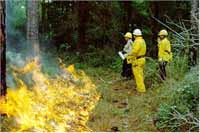Hundreds of Florida wildfire evacuees still waiting to go home
Authorities briefly reopened two highways crossing north Florida into Georgia on before dense wildfire smoke forced them to again halt traffic, while hundreds of Florida residents waited to return to their threatened homes.

Officials said Sunday that the wildfire that had raced through the Okefenokee Swamp in southeast Georgia and into Florida had charred more than 233,700 acres (94,600 hectares) - or about 365 square miles (945 square. kilometers) - since it was started by lightning a week ago.
Officials warned that storms in the forecast Sunday could bring either much-needed rain or lightning.
Authorities reopened 90 miles (145 kilometers) of Interstates 75 and 10 for a couple of hours Sunday morning after wind helped push the heavy smoke away from the highways. But they were later forced to close 35 miles (56 kilometers) of I-75 from the Florida-Georgia state line to Lake City, Florida, as well as a 40-mile (64-kilometer) stretch of I-10 in Florida.
A 15-mile (24-kilometer) stretch of I-75 from Valdosta, Georgia, to the Florida state line remained open Sunday.
About 570 residents were not being allowed to return to 150 homes evacuated between I-10 and the Florida-Georgia state line.
The fire started May 5 in the middle of the Okefenokee National Wildlife Refuge. It took just six days to grow larger than another wildfire that has burned nearly 121,000 acres (49,000 hectares) of Georgia forest and swampland over more than three weeks. The small fire was started by a tree falling on a power line.
The Okefenokee National Wildlife Refuge and Georgia's Steven C. Foster State Park inside it remained closed.
Haze from the fires had traveled as far south as the Miami area, about 340 miles (550 kilometers) away.
The smoky skies over South Florida have disoriented birds, causing many to fly into buildings, wildlife experts said. More than 100 warblers and other small birds found injured on the ground have been brought to the Pelican Harbor Seabird Station in Miami to recover, said Wendy Fox, the agency's executive director.
"The smoke's not good for anybody, but obviously, it's throwing something off for them," Fox said.
Elsewhere, a blaze feeding on drought-stricken forest in northern Minnesota was only 15 percent contained as of Sunday. The fire had burned a combined 93 square miles (241 square kilometers) in Minnesota and nearby Canada. Meteorologists said there was a 60 percent of thunderstorms Sunday night. The storms weren't expected to bring enough rain to counterbalance the danger from high winds and lightning.
The fire had closed about half of the 57-mile(92-kilometer)-long Gunflint Trail, a key route from Grand Marais into the Boundary Waters Canoe Area wilderness that is dotted with resorts and lake homes. A fire jumped a defense line designed to keep it away from 20 or so homes on Loon Lake on Sunday, and helicopters dumped water on the flames to contain it.
Officials said Sunday the fire had destroyed 133 buildings, including 61 residences. They estimated the value of buildings lost at $3.7 million (EURO2.74 million).
Off the coast of Southern California, continued cool weather Sunday helped firefighters on Santa Catalina Island maintain control of a blaze that had threatened the resort community of Avalon.
The 4,200-acre or 6.5-square-mile fire was 76 percent contained Sunday and was expected to be encircled by Tuesday evening. One home and six businesses burned Thursday but no one was seriously injured.
Subscribe to Pravda.Ru Telegram channel, Facebook, RSS!


